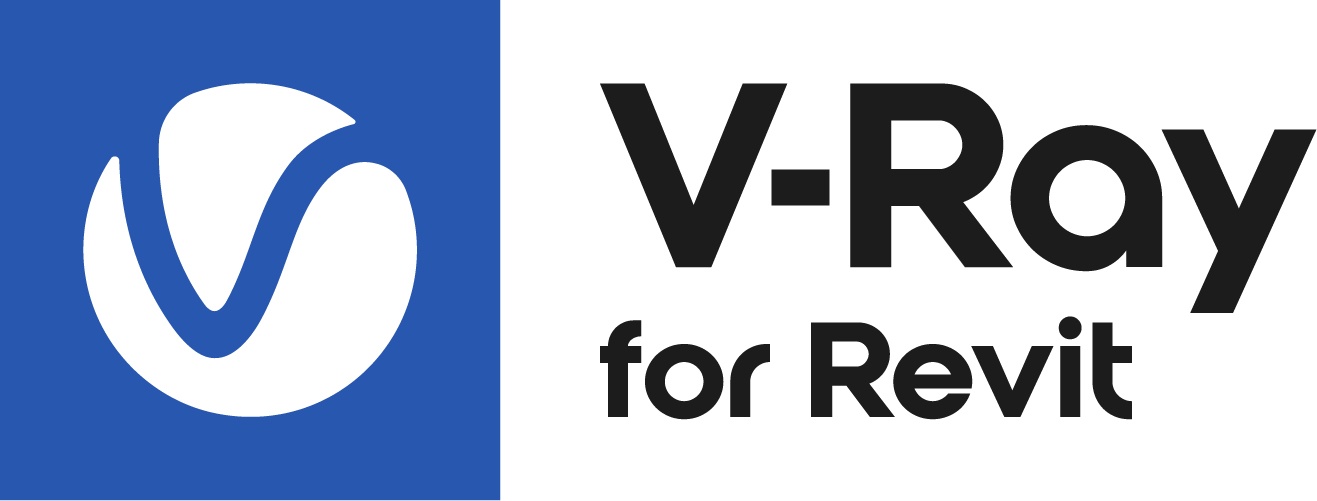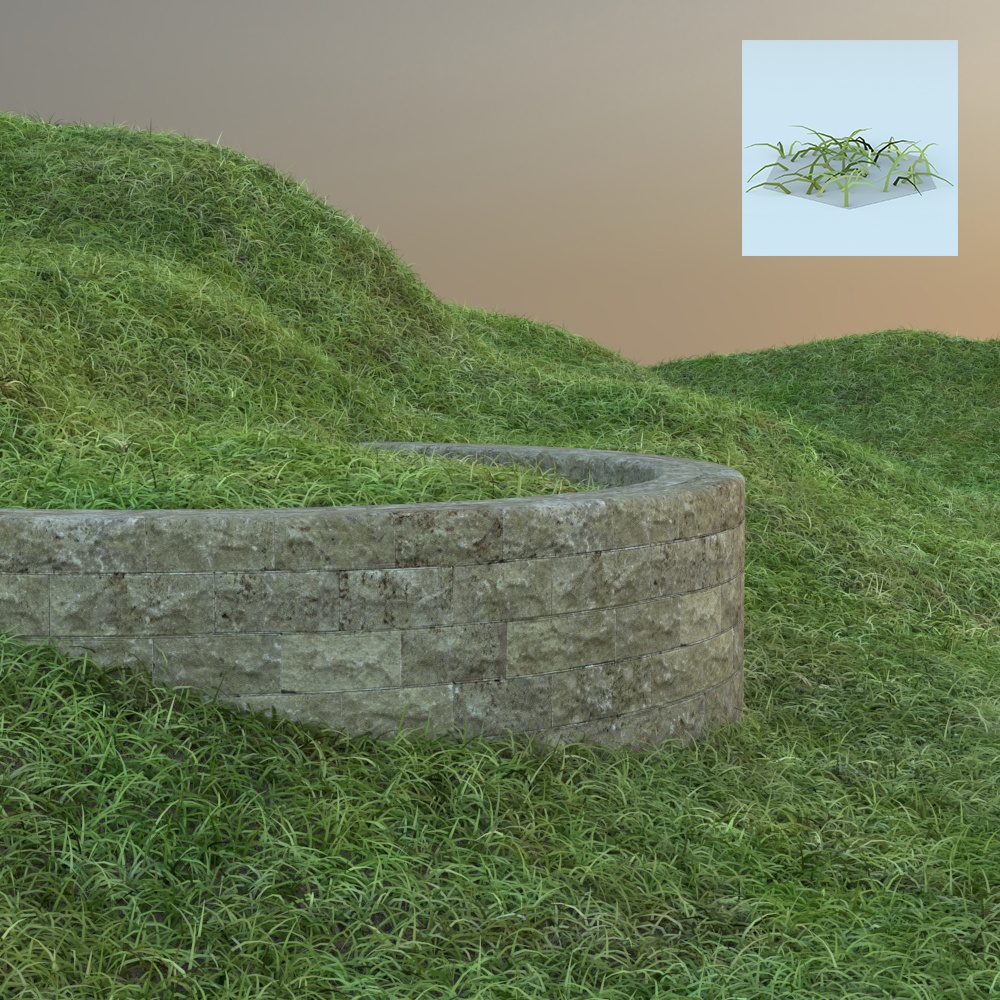This page provides information about V-Ray Fur in V-Ray for Revit.
Overview
V-Ray Fur is commonly used for simulating grass cover or textile fibers.
UI Path
Creating Fur:
||V-Ray Asset Editor|| > Create Asset > Geometries > Fur
||V-Ray Asset Editor|| > Geometry > Fur
Assigning Fur:
||Appearance Manager|| > Materials tab > Add V-Ray Grass/Fur
Workflow
- Create a Fur geometry in the Asset Editor from the Geometry drop-down menu or from Create Asset > Geometries > Fur.
Currently, the Fur geometry is not assigned to any object in the Revit model and it is not visible during rendering. - In the Appearance Manager, navigate to the material that needs Fur.
- From the V-Ray drop-down menu next to it, select Fur. A grey dot indicates that the Fur is assigned to that material. All objects that have the material assigned to them also acquire the Fur. A drag-and-drop option is also available for assigning Fur to any material in the Appearance Manager.
- Materials with assigned Fur can be filtered from the Filter icon (), which is located in the search window.
- Asset Editor - Enables/disables the Fur, applied for all the materials, globally.
- Appearance Manager - Enables/disables the Fur, applied on the selected material.
In order to render realistic grass in V-Ray Vision, create Fur in the Asset Editor and rename it to Grass. Only materials associated with that type of Fur (i.e. using Grass as a key word) will be rendered as covered with realistic 3D grass.
Parameters
Most numeric V-Ray parameters come with a slider to make fine-tuning easier. Each slider is set to a default range of recommended or commonly used values.
If a value above that range is used the slider adapts by increasing its range accordingly (2x the input value) to maintain usability. If a value below the current slider range is used, the slider again adjusts its range by shrinking it to twice the amount of the input value.
Note that the slider range does not indicate the parameter's total minimum and maximum input values. The absolute minimum and maximum values of each parameter can be found by hovering over its spinbox.
Distribution – Specifies how the density of strands is determined over the source object:
Per Face – Every face generates the specified number of fur strands. Specifies the number of fur strands per face of the source object.
Per Area – The number of strands for a given face is based on the size of that face. Smaller faces have fewer strands, larger faces have more strands. Every face has at least one strand.
Count (Area) – The number of strands for a given face is based on the size of that face. Smaller faces have fewer strands, larger faces have more strands. Every face has at least one strand. For more information, see the example Count Area below.
Density Map – The map is a multiplier for the strand density. Black portions of the map correspond to zero density (effectively no fur is generated in these areas). White represents the normal strand density, as specified by the Distribution parameter.
Length – Specifies the length of the fur strands. See the Length example and the Maps example below for more information.
Thickness – Specifies the thickness of the fur strands. It measures the strand radius. See the Thickness example and the Maps example below for more information.
Taper – Adds a taper to the individual strands of fur. Increasing this value makes each strand thinner at its upper end and wider at its base. See the Taper example below for more information.
Gravity – Controls the force that pulls fur strands down along the Z-direction. See the Gravity example and the Maps example below for more information.
Bend – Controls the elasticity of the fur strands. When set to 0.0, all strands are stiff and straight lines. Greater values cause the strands to bend (e.g. under the influence of the Gravity parameter). See the Bend example and the Maps example below for more information.
Global Scale – Globally controls the scale of the fur in the project. See the Global Scale example below for more information.
Knots – Controls the number of connected straight segments the fur strands are rendered in. See the Knots example below for more information.
The unit-dependent parameters coming from V-Ray Fur are always measured in Revit standard units - feet.
These include: Length, Thickness, Curl: Curl radius, Level of Distance: Start Distance, Rate and Distribution: per Area Count(Area) parameter which is measured in square feet.
Example: Count Area
Example: Length
Example: Thickness
Example: Taper
Example: Gravity
Example: Bend
Example: Global Scale
Example: Knots
Variance
The Direction, Length, Thickness and Gravity parameters in this rollout add variation to their corresponding parameters from the Parameters rollout. Values range from 0.0 (no variation) to 1.0. See the Variance examples below for more information.
Bend Direction Map – Specifies a bend direction of the fur strands. This is the direction the fur strands are curved to (the amount of curvature is also controlled by the Bend parameter). The red component of the texture is offset along the U texture direction, the green component is the offset along the V texture direction, and the blue component is the offset along the surface normal.
Initial Direction Map – Specifies the initial direction of the fur strands. The red component is offset along the U texture direction, the green component is the offset along the V texture direction, and the blue component is the offset along the surface normal.
Variance Direction
Variance Gravity
Variance Length
Variance Thickness
Curl
Curl – When enabled, adds curls to the fur.
Curl Radius – Specifies the radius of an individual curl. See the Curl Radius example below for more information.
Curl Radius Variation – Allows you to add variation to the curl radius of the fur strands. See the Curl Radius Variation example below for more information.
Number of curls – Specifies the number of curls on a strand. See the Number of Curls example below for more information.
Curl Map – This map is a multiplier for the strand Curl. Black portions of the map correspond to no curl, and white represents the set curl, as specified by the Distribution parameters.
Example: Curl Radius
Example: Curl Radius Variation
Example: Number of Curls
Example: Maps
Level of Detail
Level of detail – When enabled, V-Ray will generate less fur geometry for parts of the project that are far away from the camera. This is done by decreasing the density of the fur strands and increasing their thickness. The level of detail function helps for two things. One, it conserves memory by decreasing the detail where it is too far to be visible, and two, it helps to reduce animation flickering of very fine fur strands when they are far from the camera.
Start distance – Specifies the distance from the camera at which V-Ray will start implementing the Level of detail adjustment. Up to this distance the fur will be generated as specified by the user. After that V-Ray will decrease the density and increase the thickness of the strand by a factor of two for every n units of space specified by the Rate parameter. See the Start distance example for more.
Rate – The rate at which the Level of detail adjustment is applied. Starting from the distance specified in the Start distance parameter, V-Ray decreases the density and increases the thickness of the strands by a factor of two for every n units of space specified by the Rate parameter. See the Rate example for more.
Start Distance
Rate
Material
Material toggle – When disabled, the V-Ray Fur is rendered in the same material it is associated with in the Appearance Manager. When enabled, it allows you to assign a different material.
Material selector – Specifies a V-Ray material that is applied to the fur geometry.
The input slot () of the Material has a context menu available, if a material is slotted. Note that materials can also be drag-and-dropped into the slot. When you right-click on it, you can Copy, Cut or Clear the selected material. If you left-click on it, the Asset Editor jumps to the slotted material.
V-Ray Fur produces flat strands if Hair material is applied to it.
Options
Gravity Direction – Manually specifies the gravity vector.
Notes
- When a Fur geometry is added to the material of a Scatter guest, it is ignored for the scattered instances. The Fur is also ignored for the original instance geometry added as a guest.


























































































